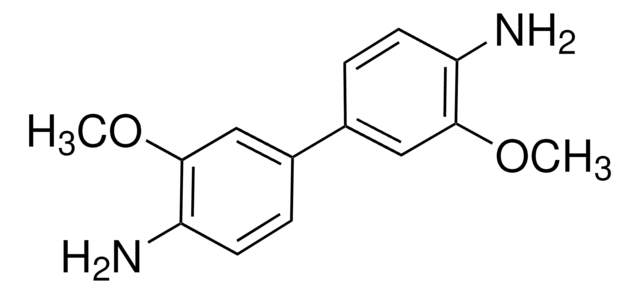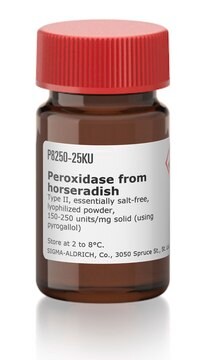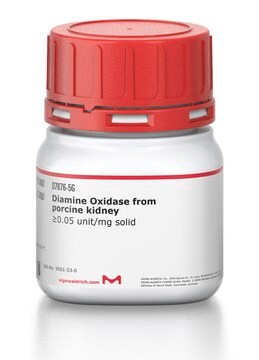D9154
o-Dianisidine dihydrochloride
tablet
Synonym(s):
3,3′-Dimethoxybenzidine dihydrochloride, Fast Blue B
About This Item
Recommended Products
product name
o-Dianisidine dihydrochloride, tablet, 10 mg substrate per tablet
Quality Level
form
tablet
solubility
water: 1 tablet/10 mL, clear, colorless
storage temp.
2-8°C
SMILES string
Cl.Cl.COc1cc(ccc1N)-c2ccc(N)c(OC)c2
InChI
1S/C14H16N2O2.2ClH/c1-17-13-7-9(3-5-11(13)15)10-4-6-12(16)14(8-10)18-2;;/h3-8H,15-16H2,1-2H3;2*1H
InChI key
UXTIAFYTYOEQHV-UHFFFAOYSA-N
Looking for similar products? Visit Product Comparison Guide
Specificity
Warning
Reconstitution
signalword
Danger
hcodes
Hazard Classifications
Acute Tox. 4 Oral - Carc. 1B - Eye Dam. 1 - Skin Corr. 1
Storage Class
6.1C - Combustible acute toxic Cat.3 / toxic compounds or compounds which causing chronic effects
wgk_germany
WGK 3
flash_point_f
Not applicable
flash_point_c
Not applicable
ppe
Eyeshields, Gloves, type P3 (EN 143) respirator cartridges
Certificates of Analysis (COA)
Search for Certificates of Analysis (COA) by entering the products Lot/Batch Number. Lot and Batch Numbers can be found on a product’s label following the words ‘Lot’ or ‘Batch’.
Already Own This Product?
Find documentation for the products that you have recently purchased in the Document Library.
Customers Also Viewed
Articles
Nitroblue Tetrazolium (NBT) is used with the alkaline phosphatase substrate 5-Bromo- 4-Chloro-3-Indolyl Phosphate (BCIP) in western blotting and immunohistological staining procedures. These substrate systems produce an insoluble NBT diformazan end product that is blue to purple in color and can be observed visually.
Our team of scientists has experience in all areas of research including Life Science, Material Science, Chemical Synthesis, Chromatography, Analytical and many others.
Contact Technical Service













